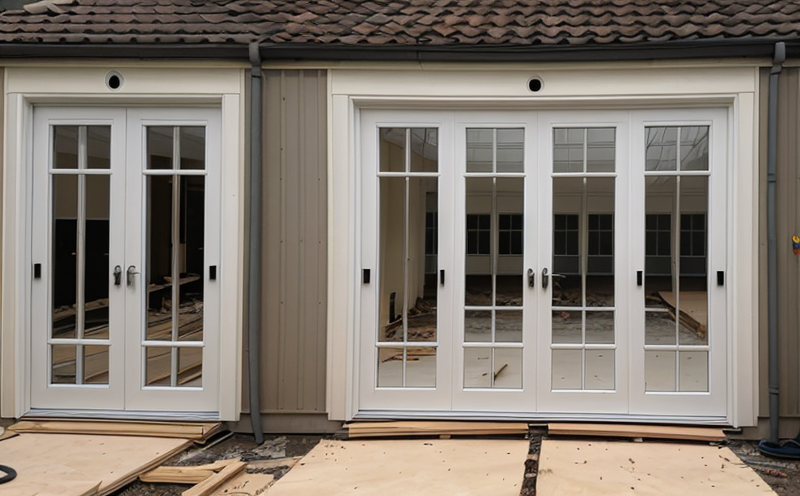EN 16034 Fire Resistance of Doors, Shutters, and Openable Windows
The European Standard EN 16034 sets out the requirements for assessing the fire resistance of doors, shutters, and openable windows. This standard is crucial in ensuring that building components provide adequate protection against fire spread during emergencies.
Fire safety testing under EN 16034 involves subjecting specimens to standardized thermal exposure conditions designed to simulate real-world fire scenarios. Specimens are exposed to a flame impinging from one side, while the other side is maintained at ambient temperature. The primary objective of this test is to determine the time it takes for the specimen to lose its structural integrity or become non-functional.
This standard applies specifically to doors, shutters, and openable windows that are used as fire protection barriers. It ensures these components can withstand prolonged exposure to fire without compromising safety. Compliance with EN 16034 is often a requirement for the installation of such products in high-risk environments like commercial buildings, residential complexes, and public spaces.
EN 16034 outlines detailed procedures for testing including specimen preparation, setup, exposure conditions, measurement techniques, and acceptance criteria. Specimens must be prepared according to specified dimensions and material composition, ensuring accurate results that reflect real-world performance under fire conditions.
| Standard Name | Year of Publication | Relevant Sections |
|---|---|---|
| EN 16034:2018 | 2019 | Section 5, Section 7 |
The testing process involves placing the specimen in a furnace where it is subjected to controlled flame impingement. Temperature and duration of exposure are carefully regulated according to EN 16034 specifications. Throughout the test, various parameters such as temperature distribution on both sides of the specimen, heat flux, and gas flow rates are monitored.
After the prescribed exposure time, the specimen is visually inspected for signs of structural damage or loss of functionality. Acceptance criteria include maintaining a minimum duration before failure occurs under specified conditions. Compliance with these standards ensures that building components meet stringent fire safety requirements.
Our laboratory adheres strictly to EN 16034 guidelines, ensuring accurate and reliable test results. We employ advanced instrumentation and methodologies to provide comprehensive assessments of fire resistance performance. Our expertise in this domain enables us to offer robust solutions for quality managers, compliance officers, R&D engineers, and procurement teams.
- Comprehensive testing services tailored to EN 16034 requirements
- Use of state-of-the-art equipment for precise measurements
- Experienced technical staff with extensive knowledge in fire safety testing
- Accurate and timely reporting based on standardized criteria
Competitive Advantage and Market Impact
Adhering to EN 16034 provides significant competitive advantages in the market. Compliance with this standard enhances a company's reputation for delivering high-quality, safe products that meet stringent regulatory requirements. This can lead to increased client trust and loyalty, as well as greater market share.
EN 16034 ensures consistent product performance across different environments, reducing variability in fire resistance outcomes. This consistency is critical for ensuring public safety and confidence in building materials. By offering this service, we help clients stay ahead of regulatory changes and industry trends, maintaining a leading position in the market.
The standard also drives innovation by encouraging manufacturers to explore new materials and designs that meet or exceed its stringent requirements. This fosters continuous improvement in product quality and safety standards.
- Enhances reputation for delivering high-quality, safe products
- Increases client trust and loyalty
- Reduces variability in fire resistance outcomes
- Fosters innovation through exploration of new materials and designs
Use Cases and Application Examples
The application of EN 16034 is particularly relevant in high-risk environments where fire safety is paramount. This includes commercial buildings, residential complexes, public spaces, and other facilities that require robust fire protection barriers.
In the context of doors, shutters, and openable windows, these components play a critical role in containing fires within specific areas of a building. For instance, in a multi-story office complex, ensuring that all exit routes are protected by EN 16034 compliant products is essential for safeguarding occupants during emergencies.
Shutters and openable windows serve as additional fire protection measures, often used in conjunction with doors to create more resilient fire barriers. In industrial settings, these components may be subjected to even more rigorous testing due to the high risk of fire incidents.
The standard's emphasis on maintaining structural integrity under extreme conditions makes it indispensable for ensuring public safety and regulatory compliance. By providing reliable test data based on EN 16034, we help clients meet these stringent requirements while enhancing product performance and reliability.





